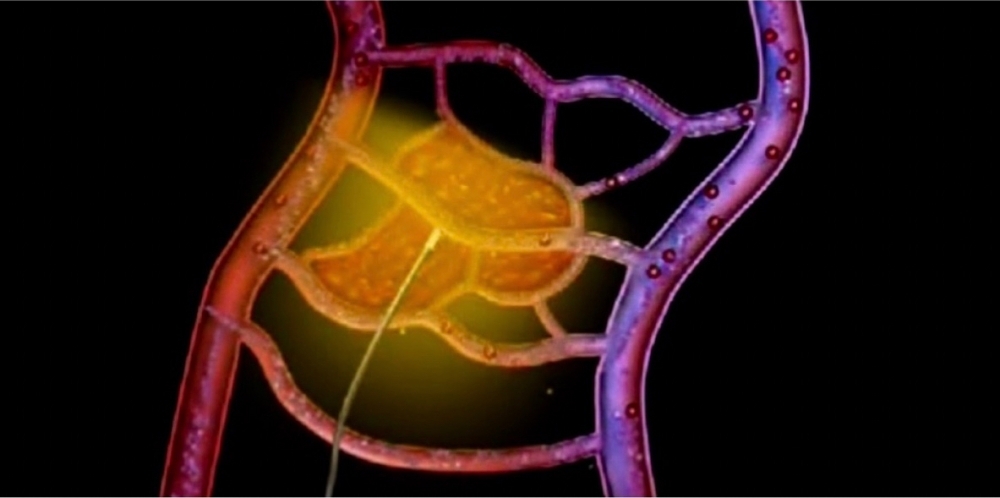


Novel therapy developed in Israel uses a laser-activated photosensitizing drug to attack early-stage prostate cancer, according to a presentation delivered to an international event on biophotonics supported by FAPESP (image: Weizmann Institute of Science)
Published on 05/13/2021
By Elton Alisson in São Carlos (SP), Brazil | Agência FAPESP – Oncologists face a dilemma when diagnosing a patient with early-stage prostate cancer. Both treatment options for these cases – tumor resection surgery and external beam radiation therapy – affect the entire prostate and may have severe side effects, such as erectile dysfunction and urinary incontinence.
A novel approach to the treatment of early-stage prostate tumors developed at the Weizmann Institute of Science in Israel offers physicians an alternative to conventional therapies and reduces the risk of unnecessary harm to patients. It is a noninvasive outpatient procedure that uses a photosensitizing drug and a light source to target only the tumor without damaging healthy tissue or the urinary tract.
One of the creators of the technique, Avigdor Scherz, a professor at the Weizmann Institute, recently visited Brazil to participate as a speaker at the São Paulo School of Advanced Science on Modern Topics in Biophotonics.
Supported by FAPESP through its São Paulo Schools of Advanced Science Program (SPSAS), the event was held on March 20-29, 2019, at the University of São Paulo’s São Carlos Institute of Physics (IFSC-USP) for graduate students and young researchers from Brazil and abroad to discuss advanced topics in biophotonics, a multidisciplinary research area that utilizes light-based technologies in medicine and the life sciences.
“We combined principles and ideas from nature with photonics to develop a novel treatment for prostate cancer that destroys only cancerous tissue without harming healthy tissue,” Scherz said in his presentation to the School.
The technique is called vascular targeted photodynamic (VTP) therapy and begins with a ten-minute intravenous infusion of a drug based on a light-sensitive pigment obtained from the chlorophyll produced by photosynthesizing bacteria (cyanobacteria).
Bacteriochlorophyll, the drug made from this substance, is activated by exposure to infrared laser light for 22 minutes via optical fibers placed in the prostate under ultrasound guidance. Activation of the drug in the cancerous tissue triggers a chain reaction generating highly reactive molecules that block the supply of blood and oxygen to tumor cells. The tumor is destroyed 16-24 hours after the procedure. Healthy tissue remains structurally and functionally intact.
“The combination of the photosensitizing drug with exposure to laser light inside blood vessels causes the simultaneous generation of nitric oxide and oxygen radicals. This leads to rapid collapse of tumor tissue vascularization,” Scherz explained.
Patients are discharged a few hours after the procedure, which lasts approximately 90 minutes and is completed in a single session. The drug remains in the bloodstream for three to four hours.
The technique has been validated in clinical trials involving 413 patients at 47 hospitals in ten European countries and at medical centers in Canada, Mexico and Israel.
The results of clinical trials held in Europe were published in 2016 in The Lancet Oncology, showing that 49% of patients achieved full remission. Only 6% had to have their prostate removed, compared with 30% of those not subjected to the treatment. The secondary effects were similar to those of a conventional biopsy.
The therapy has been approved in Israel and Mexico. It is being evaluated by the European Medicines Agency (EMA), the US Food and Drug Administration (FDA), and Brazil’s National Health Surveillance Agency (ANVISA).
The development of the new treatment resulted in 15 patents, which supported technology transfer and the establishment of several startups in Israel, including Steba Biotech, which developed the software, laser and optical fibers. “The FDA is at an advanced stage in its analysis of this new treatment,” Scherz said.
Antitumor immunity
The researchers plan to test VTP therapy in cases of more advanced prostate cancer, evaluate whether immune system modulation during treatment improves the therapy’s efficacy and safety, and investigate its capacity to develop antitumor immunity.
According to Scherz, the new approach has shown promising results in experiments with animals and can be used to treat not only prostate cancer but also pancreatic cancer and age-related macular degeneration.
“Like tree leaves, nature gets rid of malfunctioning organs by simultaneously generating nitric oxide and oxygen radicals. It’s the same with the method we’ve developed. We want to use the same principle to treat malignant tumors and other diseases,” Scherz said.
The innovative treatment is the result of 20 years of research by Scherz, a plant scientist, in collaboration with biochemist Yoram Salomon, who was also a professor at the Weizmann Institute and died in 2017.
In the early 1990s, the two scientists began studying photosynthesis and found that some types of chlorophyll play key roles, such as light collection and energy conversion. Based on this observation, they deduced that the interaction between chlorophyll and light in the tissue of photosynthetic bacteria could provide new opportunities for the treatment and diagnosis of cancer and other pathologies.
After testing more than 200 molecules, the researchers arrived at bacteriochlorophyll derivatives with higher stability, water solubility and better capacity for pharmaceutical use. In initial tests with animals, they showed that the illumination of tumors with laser light shortly after the intravenous injection of bacteriochlorophyll resulted in a very high cure rate.
More information about the São Paulo School of Advanced Science on Modern Topics in Biophotonics: www.biophotonics2019br.com.
Source: https://agencia.fapesp.br/30261